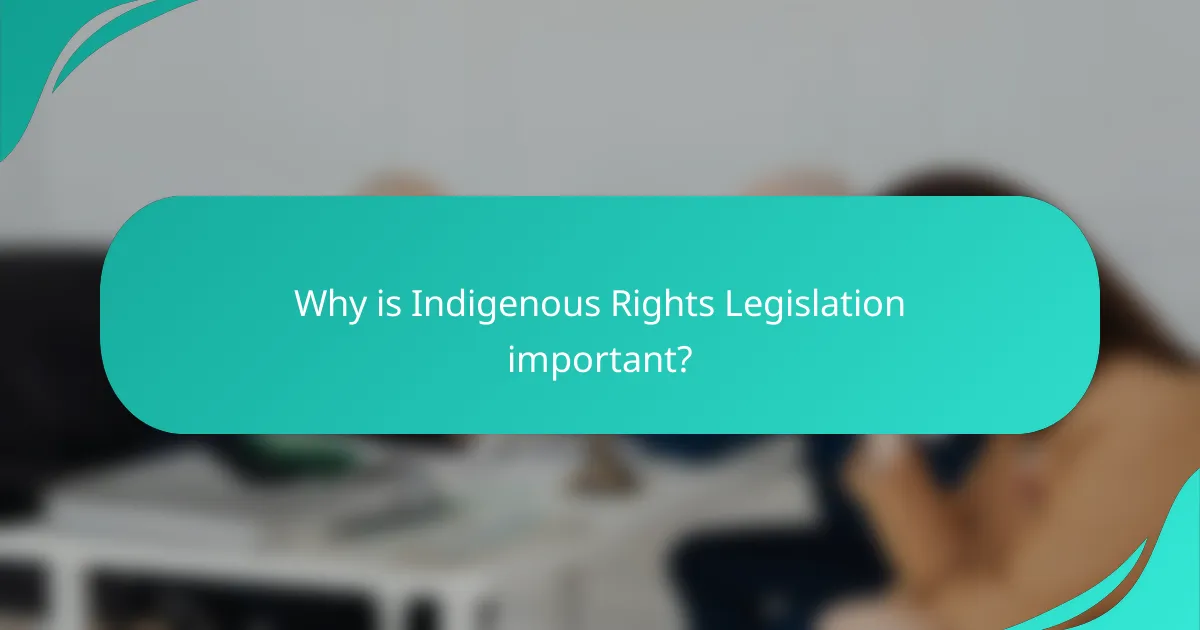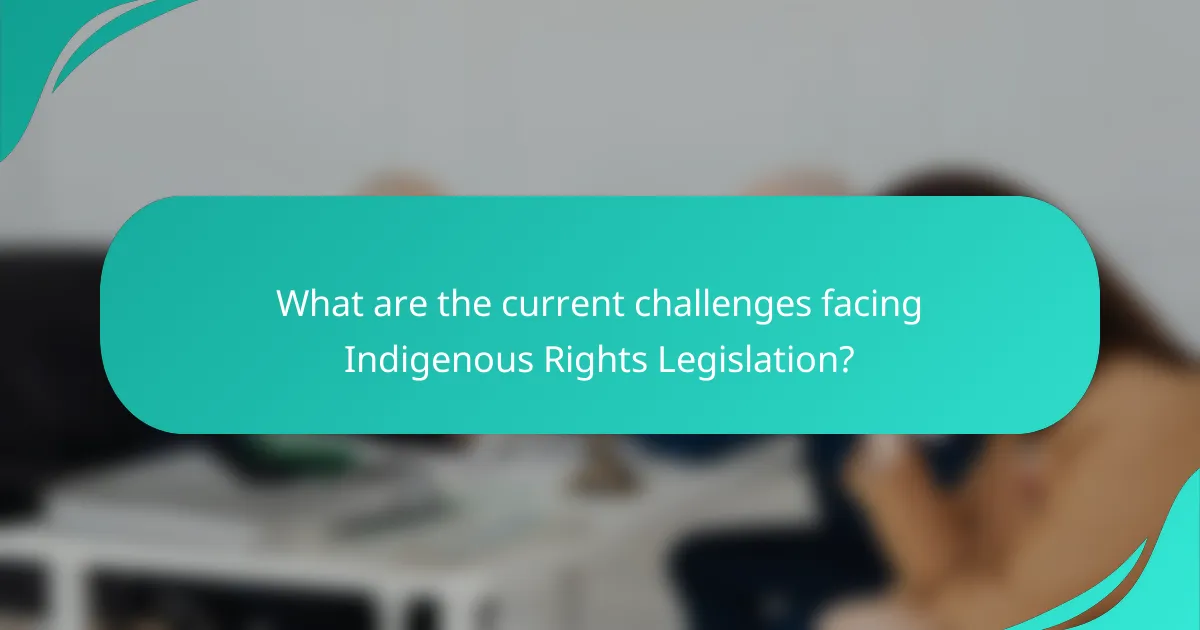
What is Indigenous Rights Legislation in Canada?
Indigenous Rights Legislation in Canada refers to laws that recognize and protect the rights of Indigenous peoples. This includes the Constitution Act of 1982, which acknowledges Aboriginal rights. The legislation aims to address historical injustices and promote self-determination. The Indian Act is another key piece of legislation, governing various aspects of Indigenous life. Additionally, the United Nations Declaration on the Rights of Indigenous Peoples influences Canadian law. These laws are essential for ensuring that Indigenous communities have a voice in governance and resource management. They also provide a framework for land claims and treaty negotiations. Overall, Indigenous Rights Legislation is crucial for advancing social justice and equity in Canada.
How did Indigenous Rights Legislation evolve in Canada?
Indigenous Rights Legislation in Canada evolved through a series of legal developments and policy changes. Initially, the Indian Act of 1876 defined the relationship between Indigenous peoples and the Canadian government. This act imposed restrictions on Indigenous governance and culture. In the 1960s, Indigenous activism led to increased awareness and demands for rights recognition. The 1982 Constitution Act included Section 35, which recognized existing Indigenous rights. Subsequent court cases, such as the Calder case in 1973, affirmed land rights and self-governance. In 1996, the Royal Commission on Aboriginal Peoples recommended comprehensive reforms. The Truth and Reconciliation Commission, established in 2008, further emphasized the need for legislative change. Overall, the evolution reflects a growing recognition of Indigenous rights within Canadian law and society.
What historical events shaped the current legislation?
The current legislation on Indigenous rights in Canada has been shaped by several key historical events. The Royal Proclamation of 1763 established the framework for recognizing Indigenous land rights. The Indian Act of 1876 further defined the relationship between Indigenous peoples and the Canadian government. The 1969 White Paper proposed to eliminate the Indian Act, which sparked significant Indigenous resistance. The Constitution Act of 1982 included Section 35, recognizing existing Indigenous rights. The 1996 Royal Commission on Aboriginal Peoples provided recommendations for reconciliation. The 2015 Truth and Reconciliation Commission called for action on Indigenous rights and recognition. Each of these events has significantly influenced the evolution of Indigenous rights legislation in Canada.
What key milestones have been reached in Indigenous rights recognition?
Key milestones in Indigenous rights recognition include the 1969 White Paper, which proposed the elimination of Indian status but faced strong opposition from Indigenous leaders. In 1982, the Constitution Act recognized and affirmed the rights of Indigenous peoples in Canada. The 1996 Royal Commission on Aboriginal Peoples called for significant reforms and acknowledgment of Indigenous rights. The 2007 United Nations Declaration on the Rights of Indigenous Peoples provided an international framework for rights recognition. The 2016 Truth and Reconciliation Commission’s report outlined actions to address historical injustices. In 2019, Bill C-92 was passed, affirming Indigenous jurisdiction over child and family services. These milestones demonstrate a progression toward recognizing and respecting Indigenous rights in Canada.
What are the main components of Indigenous Rights Legislation?
Indigenous Rights Legislation primarily includes recognition of land rights, self-governance, and cultural preservation. Land rights ensure that Indigenous peoples have ownership and control over their traditional territories. Self-governance allows Indigenous communities to exercise political authority and manage their affairs. Cultural preservation focuses on protecting Indigenous languages, traditions, and practices. These components are essential for ensuring the rights and well-being of Indigenous populations. The Constitution Act of 1982 and various treaties provide legal frameworks supporting these components.
What types of rights are recognized under this legislation?
The legislation recognizes various types of rights for Indigenous peoples in Canada. These rights include land rights, which affirm Indigenous ownership and stewardship of traditional territories. Additionally, the legislation acknowledges self-governance rights, allowing Indigenous communities to make decisions about their own affairs. Cultural rights are also recognized, ensuring the preservation and practice of Indigenous languages, traditions, and customs. Moreover, economic rights are included, which support Indigenous participation in economic development. These rights are grounded in treaties, court rulings, and constitutional provisions that validate the unique status of Indigenous peoples in Canada.
How do these rights impact Indigenous communities?
Indigenous rights significantly impact Indigenous communities by affirming their sovereignty and self-determination. These rights enable communities to govern themselves according to their traditions and laws. They also ensure access to ancestral lands and resources, which is vital for cultural preservation. For instance, the recognition of land rights can enhance economic opportunities through resource management. Furthermore, these rights promote social justice and address historical injustices faced by Indigenous peoples. According to the Truth and Reconciliation Commission of Canada, recognizing these rights is essential for reconciliation. Ultimately, these rights empower Indigenous communities to thrive culturally, socially, and economically.

Why is Indigenous Rights Legislation important?
Indigenous Rights Legislation is important because it recognizes and protects the rights of Indigenous peoples. This legislation helps to address historical injustices faced by these communities. It ensures their participation in decision-making processes that affect their lands and resources. Indigenous Rights Legislation also promotes cultural preservation and the continuation of traditional practices. In Canada, the Constitution Act of 1982 acknowledges the rights of Indigenous peoples, providing a legal framework for their protection. The United Nations Declaration on the Rights of Indigenous Peoples further supports these rights on a global scale. By implementing this legislation, governments can foster reconciliation and improve relationships with Indigenous communities.
What benefits does Indigenous Rights Legislation provide to Indigenous peoples?
Indigenous Rights Legislation provides various benefits to Indigenous peoples, including recognition of land rights and self-governance. This legislation affirms their inherent rights to traditional territories. It facilitates access to resources and economic opportunities on these lands. Furthermore, it promotes cultural preservation and revitalization of Indigenous languages. Legal frameworks support Indigenous participation in decision-making processes. These rights lead to improved social and health outcomes for Indigenous communities. Studies show that recognizing Indigenous rights can reduce poverty levels. Overall, Indigenous Rights Legislation empowers Indigenous peoples and strengthens their communities.
How does this legislation promote social justice and equity?
This legislation promotes social justice and equity by recognizing and affirming Indigenous rights. It aims to address historical injustices faced by Indigenous communities in Canada. The legislation provides mechanisms for consultation and collaboration between Indigenous peoples and the government. It seeks to ensure equitable access to resources and decision-making processes. Furthermore, it includes provisions for land restitution and self-determination. These measures are intended to empower Indigenous communities and reduce disparities. Research shows that such legislation can improve socio-economic conditions for Indigenous peoples. For example, the 2019 report by the Assembly of First Nations highlights increased community engagement and resource management.
What role does it play in reconciliation efforts in Canada?
Indigenous rights legislation plays a crucial role in reconciliation efforts in Canada. It aims to address historical injustices faced by Indigenous peoples. This legislation recognizes and affirms Indigenous rights. It promotes self-determination and governance for Indigenous communities. The United Nations Declaration on the Rights of Indigenous Peoples (UNDRIP) influences Canadian law. In 2019, Canada adopted UNDRIP into federal law. This commitment supports the rights of Indigenous peoples across the country. Such legislation fosters dialogue and collaboration between Indigenous and non-Indigenous communities. It is essential for building trust and mutual respect in reconciliation processes.
How does Indigenous Rights Legislation interact with Canadian law?
Indigenous Rights Legislation interacts with Canadian law through constitutional recognition and legal frameworks. The Constitution Act of 1982 acknowledges Aboriginal rights, which include treaty rights and land claims. This constitutional recognition mandates that Indigenous rights must be considered in legislative processes. Moreover, the Supreme Court of Canada has ruled on various cases, reinforcing the obligation of the government to consult Indigenous peoples. For example, in the landmark case of Calder v. British Columbia, the court recognized the existence of Aboriginal title. This interaction ensures that Indigenous rights are integrated into Canadian law, influencing policy and governance.
What are the challenges in integrating Indigenous rights into existing legal frameworks?
Integrating Indigenous rights into existing legal frameworks faces several challenges. These include a lack of recognition of Indigenous sovereignty within national laws. Many legal systems prioritize state interests over Indigenous rights. This can result in conflicts regarding land use and resource management. Additionally, legal definitions of Indigenous rights can be vague or inconsistent. Historical treaties may not be honored or interpreted correctly. There is often insufficient consultation with Indigenous communities during legislative processes. Furthermore, systemic biases within legal institutions can hinder fair representation of Indigenous perspectives. These challenges complicate the effective implementation of Indigenous rights in Canada.
How do courts interpret Indigenous rights in legal cases?
Courts interpret Indigenous rights by examining constitutional provisions and legal precedents. The Constitution Act of 1982 recognizes and affirms the rights of Indigenous peoples in Canada. Courts often rely on the landmark Supreme Court case, Calder v. British Columbia (1973), which acknowledged Indigenous land rights. They assess historical treaties and agreements to determine the scope of these rights. Courts also consider the principles of reconciliation and respect for Indigenous sovereignty. Judicial interpretation aims to balance Indigenous rights with provincial and federal interests. Recent rulings emphasize the need for consultation and accommodation in resource development projects. Overall, courts play a crucial role in defining and protecting Indigenous rights in Canada.

What are the current challenges facing Indigenous Rights Legislation?
Current challenges facing Indigenous Rights Legislation include inadequate consultation processes, lack of enforcement mechanisms, and systemic discrimination. Inadequate consultation often leads to decisions made without proper engagement with Indigenous communities. This undermines the intent of legislation meant to protect Indigenous rights. Lack of enforcement mechanisms results in a failure to hold parties accountable when rights are violated. Systemic discrimination persists in legal frameworks, hindering the realization of Indigenous rights. These challenges are exacerbated by historical injustices and ongoing socio-economic disparities faced by Indigenous peoples in Canada.
What obstacles do Indigenous communities encounter in exercising their rights?
Indigenous communities encounter several obstacles in exercising their rights. These include legal complexities that often hinder the recognition of their rights. Bureaucratic barriers delay the implementation of policies meant to protect Indigenous rights. Limited access to resources restricts their ability to advocate effectively. Discrimination and systemic biases within legal frameworks further complicate their efforts. Additionally, inadequate consultation processes undermine their participation in decision-making. Historical injustices contribute to ongoing mistrust between Indigenous communities and government entities. These challenges collectively impede the full realization of Indigenous rights in Canada.
How does government policy impact Indigenous rights implementation?
Government policy significantly impacts Indigenous rights implementation by shaping legal frameworks and funding allocations. Policies can either support or hinder the recognition of Indigenous rights. For example, the Canadian government’s adoption of the United Nations Declaration on the Rights of Indigenous Peoples (UNDRIP) signals a commitment to uphold these rights. Conversely, policies that prioritize resource extraction without Indigenous consultation can lead to rights violations. Historical contexts, such as the Indian Act, illustrate how government policies have historically marginalized Indigenous communities. Effective implementation of Indigenous rights relies on consistent policy support and active collaboration with Indigenous leaders. The success of these policies is often measured by the extent to which Indigenous communities are involved in decision-making processes.
What are the ongoing legal battles regarding Indigenous rights?
Ongoing legal battles regarding Indigenous rights in Canada involve various claims for land, self-governance, and resource management. Indigenous groups are challenging government decisions that affect their traditional territories. These cases often cite the duty to consult and accommodate Indigenous peoples. For example, the Supreme Court case of Tsilhqot’in Nation v. British Columbia affirmed Indigenous land rights in 2014. Another significant case is the appeal by the Mikisew Cree First Nation regarding the federal government’s duty to consult on legislation affecting their rights. Additionally, legal actions are ongoing regarding the implementation of the United Nations Declaration on the Rights of Indigenous Peoples (UNDRIP). These battles highlight the complexities of reconciling Indigenous rights with Canadian law.
How can individuals and organizations support Indigenous rights?
Individuals and organizations can support Indigenous rights by advocating for policy changes that recognize and protect these rights. They can engage in education and awareness campaigns to inform the public about Indigenous issues. Supporting Indigenous-led initiatives and businesses fosters economic empowerment. Donations to Indigenous organizations help fund legal battles and community projects. Participation in Indigenous events promotes cultural understanding and solidarity. Collaborating with Indigenous leaders ensures that their voices are heard in decision-making processes. Legal support can assist in challenging injustices faced by Indigenous communities. Lastly, respecting Indigenous lands and practices is crucial for their cultural preservation and autonomy.
What actions can be taken to advocate for Indigenous rights effectively?
To advocate for Indigenous rights effectively, individuals can engage in several key actions. First, they can educate themselves about Indigenous histories and issues. Understanding the context is crucial for informed advocacy. Second, they can support Indigenous-led organizations and initiatives. This ensures that advocacy efforts align with the needs and desires of Indigenous communities. Third, individuals can participate in advocacy campaigns that promote Indigenous rights. These campaigns often focus on policy changes or public awareness. Fourth, they can attend community meetings and listen to Indigenous voices. This fosters meaningful dialogue and collaboration. Fifth, individuals can use social media to amplify Indigenous perspectives and issues. Raising awareness through these platforms can reach a broader audience. Lastly, they can advocate for policy changes at local, provincial, and federal levels. Engaging with lawmakers can lead to legislative reforms that protect Indigenous rights.
How can awareness and education contribute to the advancement of Indigenous rights?
Awareness and education are crucial for advancing Indigenous rights. They foster understanding of Indigenous cultures and histories. This understanding can lead to greater respect for Indigenous communities. Increased awareness can also challenge stereotypes and misconceptions about Indigenous peoples. Education equips individuals with knowledge about legal rights and treaties. This knowledge empowers Indigenous communities to advocate for their rights effectively. Studies show that communities with higher awareness levels see improved relations with government entities. For example, the Truth and Reconciliation Commission of Canada emphasizes education in promoting reconciliation.
Indigenous Rights Legislation in Canada encompasses laws that recognize and protect the rights of Indigenous peoples, including the Constitution Act of 1982 and the Indian Act. This legislation aims to rectify historical injustices, promote self-determination, and ensure Indigenous participation in governance and resource management. Key components include land rights, self-governance, and cultural preservation, while significant milestones mark the evolution of these rights through historical events and legal developments. The article further explores the impact of this legislation on Indigenous communities, the challenges faced in implementation, and the ongoing legal battles regarding Indigenous rights. Additionally, it highlights the importance of awareness and education in advancing these rights.




